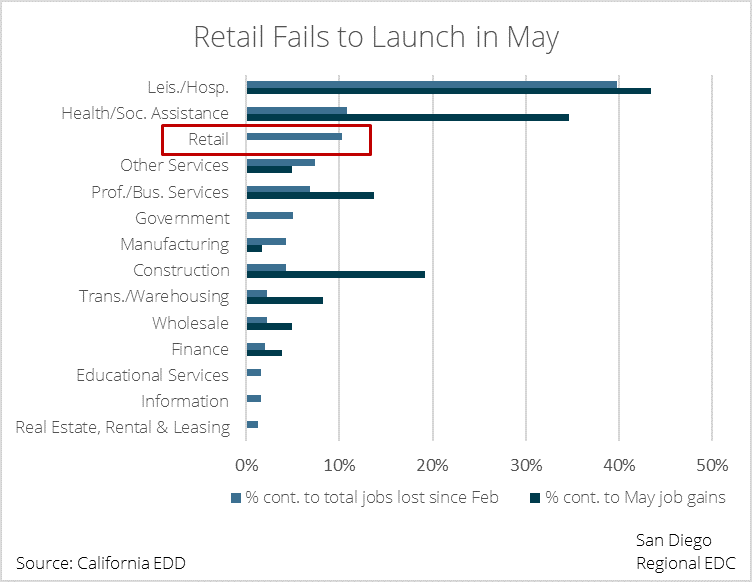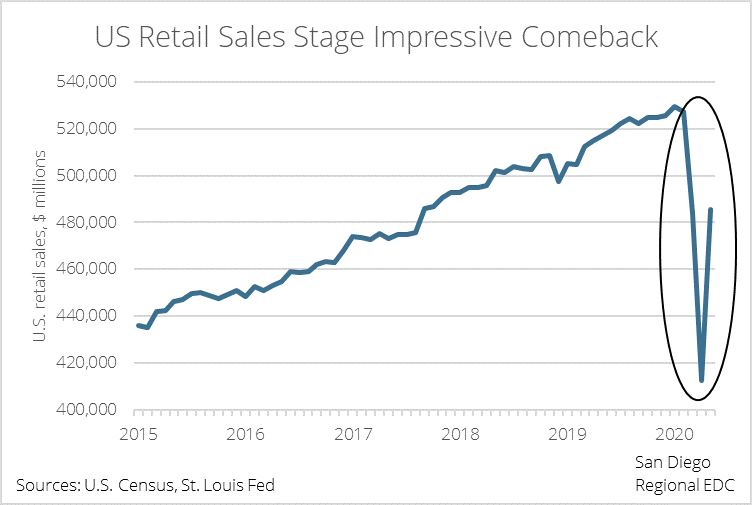San Diego’s May employment report roundly beat expectations. Against all odds, the region recovered 18,200 jobs lost during COVID-19. While this represents less than 10 percent of the 223,700 payrolls lost from February to April 2020, it’s still a promising sign that the local job market has turned the corner. Eating and drinking establishments, ambulatory healthcare, and construction each saw impressive rebounds in May 2020. Conspicuously absent from last month’s turnaround, however, was retail.

Clothing stores alone have accounted for more than a third of all retail-based layoffs, and nearly two in every three clothing store workers were let go from February to May. That is even more severe than the losses suffered by restaurants and bars, which cut nearly half of their staffs during the COVID outbreak.
Since February, retail jobs lost have totaled 24,000, with 300 workers let go in May. While May’s retail job losses aren’t alarming in the context of COVID, it indicates that the industry is yet to initiate a recovery.
GREEN SHOOTS
Nascent signs are emerging that retail’s long-awaited rebound moment has come. Locally, many shops reopened their doors to customers in June with modified social distancing protocols in place. This is similar to other parts of the country last month, leading to May’s record 17.7 percent jump in U.S. retail sales. Now that San Diego retailers have also reopened, it’s not unreasonable to assume a bounce back similar to May’s national retail sales figure could emerge locally in June.

An impact analysis that links local retail sales to employment suggests that if the same trends in the U.S. retail sales report were to play out here, we could expect a little more than 6,000 of the 24,000 retail jobs lost between February and May to be recovered in June alone. Sales at U.S. clothing stores rebounded an astonishing 188 percent in May. A similar spike in sales receipts in San Diego would be consistent with a June recovery of roughly 3,000—or two in five—of the 8,200 jobs lost at clothing stores from February to May. That is even more impressive than May’s 15 percent jobs rebound at eating and drinking establishments, and would bring the retail recovery more in line with other industries after a false start of sorts last month.
While this analysis is in line with the broader national trend, there are several caveats to consider.
First, the above only looks at one data point, which is a national sales report that may not reflect all of the idiosyncrasies of the San Diego retail industry. Additional data in the coming weeks, including June’s U.S. jobs report, will allow us to refine the estimates above.
Second, the 17.7 percent jump in U.S. retail sales reflects a weighted average of different—and potentially conflicting—regional trends. In other words, May’s rebound in retail sales may have been even stronger in newly reopened parts of the country than the topline figure of 17.7 percent would suggest. That is because the sales bump in those regions would have had to more than make up for steady or falling sales in other states like New York and California that hadn’t yet fully reopened.
Finally, any recovery could prove to be a false positive if thresholds are triggered that cause local, county, or state officials to pause or even walk back reopening.
Taken together, barring a spike in COVID cases, it looks like retail will finally join in the recovery. June’s employment report, which is due to be released on July 17, should ultimately confirm this. We’ll be reporting back on the health of retail and other industries as more data become available.
For more COVID-19 recovery resources and information, please visit this page.
Regardless of how this all plays out, EDC is here to help. You can use the button below to request our assistance with finding information, applying to relief programs, and more.
You also might like: